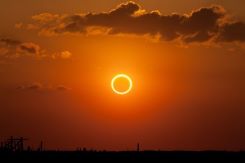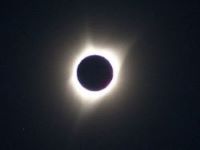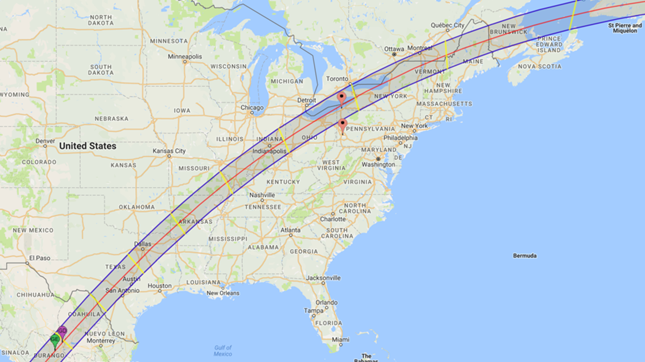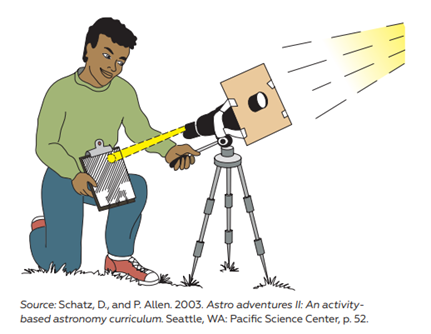Get Ready for the 2023-24 Solar Eclipse 'Double-Header'
By Dennis Schatz and Andrew Fraknoi
Posted on 2023-08-30

Disclaimer: The views expressed in this blog post are those of the author(s) and do not necessarily reflect the official position of the National Science Teaching Association (NSTA).
The Two Eclipses
The next school year offers the highly unusual opportunity to see two eclipses of the Sun in North America: a solar eclipse “Double Header.” An annular (ring of fire) eclipse will occur on October 14, 2023, followed by a total eclipse on April 8, 2024.


Everyone in North America (some 500 million people) will see at least a partial eclipse of the Sun each time, while the people located in the narrow path on the following maps with see the annular or total eclipse.

Map by Fred Espenak, Eclipsewise.com

Eclipse Maps by Fred Espenak, Eclipsewise.com
We will not have the opportunity to see another total eclipse cross the United States until 2045, so the coming year is the perfect opportunity to use these beautiful celestial events as teachable moments. You can explore key science concepts with your students, including what causes the phases of the Moon and why we have both solar and lunar eclipses.
NSTA Solar Eclipse Resources
NSTA has produced a variety of free resources and guides about the eclipses, collected on a special eclipse page at https://www.nsta.org/eclipse. We like to think of this as one-stop shopping for eclipse information and activities.
Among the materials available on NSTA web page are these:
- Solar Eclipse Guide for Educators. This 28-page, illustrated booklet includes ways to find out what will happen at your location, background and teaching suggestions regarding the eclipses, and safe viewing strategies.
- Eclipse Handouts to Share with Family Members and Friends. Two-page handouts for each eclipse that give the key facts about what happens during the eclipse and suggestions for safe viewing strategies
- Eclipse Resources Collection. Guides to free eclipse-related activities you can do at home; eclipse connections in fiction, films, music, and other fields; reliable eclipse websites; and more
Learning Activities for the Classroom
Especially relevant to classroom teachers are articles on specific Learning Activities Regarding Lunar Phases and Eclipses from the three K–12 NSTA journals. Scroll down on the NSTA eclipse web page to find the link to the journals with learning activities appropriate for elementary, middle school, and high school students.
These articles include a variety of activities, often using low-cost materials. They were designed using recommendations about three-dimensional learning outlined in A Framework for K–12 Science Education. Modeling and argumentation play a major role as students manipulate a simple model of the Earth and Sun, then add a plastic foam ball as the Moon. This allows them to understand what causes the phases of the Moon and what phase it must be in to produce different kinds of eclipses. The model also allows students to discover why it is rare to be in a place to experience total solar eclipse.

Photo by Dennis Schatz
At the higher grade levels, Hula Hoops can model the orbit of the Moon around the Earth and the apparent path of the Sun across the sky as we see it from Earth (the ecliptic). This model helps students discover how often eclipses occur.

Photo by Andrew Fraknoi
Safe Solar Eclipse Viewing
Key to making the eclipses a successful learning experience is knowing how to observe them safely. Important Safety Note—You cannot look directly at the Sun during a partial or annular eclipse without using special viewing filters (glasses) or observing the eclipse indirectly.
The good news is that you can purchase safe solar-viewing glasses inexpensively, and there are many easy-to-do indirect ways to view the eclipse. See more detail about this in the NSTA Solar Eclipse Guide for Educators (http://bit.ly/eclipsesforteachers).
One of our favorite ways to view a solar eclipse is to use something found in most homes: a colander for rinsing pasta or salad. To use it during the eclipse, stand with your back to the Sun and hold the colander so that the Sun’s light shines through it onto the ground or a wall. Inside the colander’s shadow, you’ll see many tiny images of the eclipsed Sun.

Another easy way to observe the eclipses indirectly is by making a simple pinhole projector, as shown in the next two drawings.


You can also view the eclipse by projecting an image of the Sun through binoculars.

This will allow you to see a larger image, and you and your students will likely see some of the sunspots on the Sun, which will be more plentiful at the time of these eclipses.

All of these methods are explained in more detail in the NSTA Solar Eclipse Observing Guide for Educators.
If you prefer to have the safe solar-viewing glasses, you can order them by mail, see if your local library has them, or buy them in local stores as the eclipse dates get closer. Just be sure you get them from a reliable source: See the information on page 14 of the NSTA Solar Eclipse Observing Guide for Educators.

The eclipses provide a wonderful, free laboratory for showing the predictable way nature’s cycles work. May you have clear skies and welcoming minds when you take your students outside to observe the eclipses.

Dennis Schatz works at the Institute for Learning Innovation, is Past President of the
National Science Teaching Association, and has authored 26 science books for children.

Andrew Fraknoi teaches astronomy at the Fromm Institute of the University of San Francisco and is the lead author of OpenStax Astronomy, a free online, introductory textbook.
Both are leaders in the Solar Eclipse Task Force of the American Astronomical Society and in the Solar Activities for Libraries (SEAL) project to distribute five million safe-viewing glasses (and information) for the upcoming eclipses through 10,000 public libraries, funded by the Gordon and Betty Moore Foundation.
They co-authored the NSTA Press books Solar Science and When the Sun Goes Dark, key resources for educators during solar eclipses. They each received the NSTA Faraday Award for excellence in science communication and have asteroids named for them in honor of their contributions to the public understanding of science.
Astronomy Earth & Space Science Instructional Materials Teaching Strategies Elementary Middle School High School Informal Education


